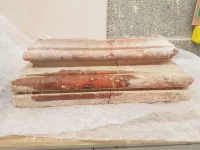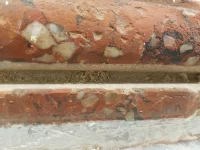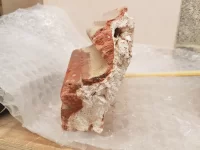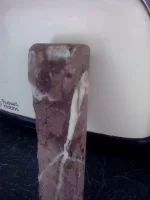Hi everyone, I have this Georgian pillar base that needs to be reproduced. As you can see from the pictures it seems to be cast but it has an aggregate that looks semi polished and probably wasn't cast like it. It is made of an old clay brick type material, quite soft, has the aggregate in and also some black material. The house it came from is in Camborne, Cornwall. Is there anyone who could shed some light on how it may have been originally made? MTIA Rob
You are using an out of date browser. It may not display this or other websites correctly.
You should upgrade or use an alternative browser.
You should upgrade or use an alternative browser.
Georgian house pillar base
- Thread starter robmiller
- Start date
smoother09
Well-Known Member
What's wrong with it?? That could be repaired no problems
The Hobo
Well-Known Member
repair what u have got with casting plaster then take a f/glass mould off it/see if original can be crushed up and re used by adding fast set cement I would go for a clay one like PROMT /failing that search your local area for stone and sand to match and try it /her is one I did years ago kept a bit for a souvineer


Attachments
Thank you for your reply. Sorry if I didn't make myself clear, my question is more directed at how it was originally made as it looks like it was cast from the side profile but due to the aggregate being polished I'm wondering whether it was cast larger than this and then shaped back to the profile it's in. Any ideas please?What's wrong with it?? That could be repaired no problems
Thank you for that. Your's looks really nice. The customer wants two complete pillars made from casting plaster for inside their vestibule to match the profile of the existing ones outside the main door (the pictured bit is obviously the bottom of the outside). We made a three piece mould yesterday and will be making the bottom part of the inside ones from white concrete to make sure it's tough enough to stand the odd knock. They are wanting to repair the outside ones, so we can't crush it up, but we thought it would look a bit naff and wondered, due to the polished aggregate in it (it's the polished aggregate in it that's causing the 'how did they do that?' question), whether it was cast slightly larger and then polished back to it's existing profile.repair what u have got with casting plaster then take a f/glass mould off it/see if original can be crushed up and re used by adding fast set cement I would go for a clay one like PROMT /failing that search your local area for stone and sand to match and try it /her is one I did years ago kept a bit for a souvineer View attachment 36420View attachment 36421
Mouldyoldspudgun
Well-Known Member
Nice one Stormin.repair what u have got with casting plaster then take a f/glass mould off it/see if original can be crushed up and re used by adding fast set cement I would go for a clay one like PROMT /failing that search your local area for stone and sand to match and try it /her is one I did years ago kept a bit for a souvineer View attachment 36420View attachment 36421
Steven Andrews
Member
Keenes cement scagliola pressed into reverse mould for decoritive face, back-filled with plaster? Looking on small phone screen without my glasses!
The Hobo
Well-Known Member
your not far away palKeenes cement scagliola pressed into reverse mould for decoritive face, back-filled with plaster? Looking on small phone screen without my glasses!
Cool, thank you for that, will investigate that further.Keenes cement scagliola pressed into reverse mould for decoritive face, back-filled with plaster? Looking on small phone screen without my glasses!
The Hobo
Well-Known Member
cant answer that without seeing it /a quick way but not permanent would be to briwax itThank you for that. Your's looks really nice. The customer wants two complete pillars made from casting plaster for inside their vestibule to match the profile of the existing ones outside the main door (the pictured bit is obviously the bottom of the outside). We made a three piece mould yesterday and will be making the bottom part of the inside ones from white concrete to make sure it's tough enough to stand the odd knock. They are wanting to repair the outside ones, so we can't crush it up, but we thought it would look a bit naff and wondered, due to the polished aggregate in it (it's the polished aggregate in it that's causing the 'how did they do that?' question), whether it was cast slightly larger and then polished back to it's existing profile.
mikeadams1985
Well-Known Member
Scag that fella
looks like scagliola/terrazzo, possibly formed by mixing clay brick dust (crushed by hand with a hammer) mixed with lime (to make it hydraulic) and some marble chips for decoration. The backing being lime/sand mortar. The marble chips are shaped to the surface but may have been soft enough for a sharp profile rule to have been used to mould it in situ, rather than it having being ground to shape with abrasives. Maybe you'll find some similar marble chips on the local beach and can test how hard they are.
Fascinating history.
Fascinating history.
Similar threads
- Replies
- 7
- Views
- 2K
- Replies
- 7
- Views
- 3K
- Replies
- 10
- Views
- 2K




